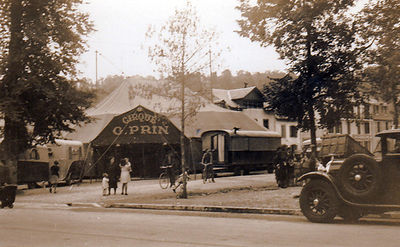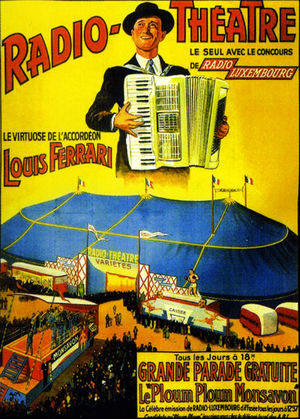Cirque Prin
From Circopedia
By Dominique Jando
The Prin family (also spelled Prein) came under the spotlight when Roland Prin married into France’s most powerful circus dynasty, the Bouglione family. Josette Bouglione (b.1930), Joseph Bouglione’s second daughter, and Roland Prin were married with great pomp in Bordeaux—where the mighty Cirque Bouglione was performing—on May 21, 1948. It was a good opportunity for a spectacular publicity stunt, with the newlyweds entering the City Hall of Bordeaux on the back of an elephant, and the religious ceremony being performed in the ring, in a cage peopled with a group of lions.
Contents
The Prin Family
Another union, that of Yolande Prin with Alfred Beautour, also gave the Prin family some attention. Yet, the origins of this family are rather obscure; their name is French, probably a contraction of a more common name, Perrin. Their circus, which was of small size, was not very well known, and therefore was rarely chronicled; it was advertised at some point as "Le plus petit des grands cirques" ("The smallest of the big circuses"). At the time of Roland’s marriage, the circus was managed by Gabriel Prin, along with his brothers Claude (known as Arsène) and Emile.Gabriel Prin was Roland’s father. With his wife, née Etiennette Louise Artique, he had had three children: The aforementioned Roland and Yolande, and Simon. Arsène (Claude) had two children, Roger and Marcel, who eventually had their own circus. (Roger and Marcel had six children each.) Emile, who was Gabriel’s sole partner after the death of Arsène, had two daughters, Gina and Lina, who both married into the Bauer family, at the time owners of the Cirque Triomph, a mid-size circus of good reputation.
Gabriel, Arsène and Emile had four more brothers: Louis (who had six children), René, Charles, and Alexis. It was (and became increasingly) a very large family. Several of its members provided the little Cirque Prin with its personnel and performers. Unfortunately, as it often happened (and still happens) with small circuses, the Prins never built their own identity, touring under names that changed from one season to another—not the best way to develop an image, a reputation and a faithful audience base.
The postwar years (1940s and 1950s) were a boon to European circuses, and some relatively modest enterprises developed into major circuses—such as the Cirque Gruss-Jeannet which became the very popular Radio-Circus, before changing its name to Medrano, Jean Richard, and Grand Cirque de France (all thriving enterprises), and finally becoming Cirque Gruss, at which point the Gruss family had long established its reputation as one of the preeminent French circus dynasties.
From Radio-Théâtre To Stop Circus
Following the Grusses, who had struck a very fruitful association with the popular radio network Radio-Luxembourg and ran the tremendously successful Radio-Circus, the Prins toured in 1951 with a Cirque Cinémonde, in association with the eponymous French movie-fan magazine, but the experience didn’t meet the Prins’ expectations and was short-lived. The Prins used their own name in 1952: the Cirque-Ménagerie Prin offered a show presented nearly exclusively by family members, whose talents, unfortunately, were not all outstanding.Finally the Prins struck big in 1953 when they were chosen by Radio-Luxembourg and the creators of the Radio-Circus to become the Radio-Théâtre, a similar enterprise that presented a variety show under canvas, with well-known singers, a few circus acts, and radio personalities. The Prins lent their equipment, and took care of the technical aspect of the enterprise. As with the Radio-Circus, the second half of the Radio-Théâtre program was devoted to the public recording of some of Radio-Luxembourg’s popular game and talent shows.
The adventure was cut short at the end of the 1954 season, when Radio Luxembourg decided to drop the Radio-Théâtre and continue with the Radio-Circus only. Yet, contrary to the Grusses, whose excellent family acts, notably equestrian, were featured in the Radio-Circus show, the Prins never had an opportunity to establish themselves with the Radio-Théâtre. When they hit the road again in 1955, their show was titled Stop Circus. It had a little success, but disappeared after a few seasons. In 1959, the Prins established another tie with the Bouglione family when Christiane Prin married Emilien Bouglione, Joseph Bouglione's third son.
Over the years, many members of this expanded family have run circuses under various titles, but rarely under their own name. Recently (as of 2015) however, two circuses were touring under the name Prin: The Cirque Gipsy Prin in France, and the Circo Prin in Spain, which had been touring in France as Cirque Maxi; unfortunately both are very small affairs, and have not done much to put the old name into the limelight! Ultimately, it is mostly its relation to the Bouglione family that has made the name Prin known among circus aficionados.
Suggested Reading
- Adrian, Sur les Chemins des Grands Cirques Voyageurs (Bourg-la-Reine, Paul Adrian Edit., 1959)
- Christian Boner, Radio-Télé-Circus — L'âge d'or du cirque de la radio et de la télévision (Paris, Le Masque Editions, 2009) — ISBN 2-9518301-6-5
See Also
- Video: Roland Prin, Cage Act, at Paris's Cirque d'Hiver (1967)








